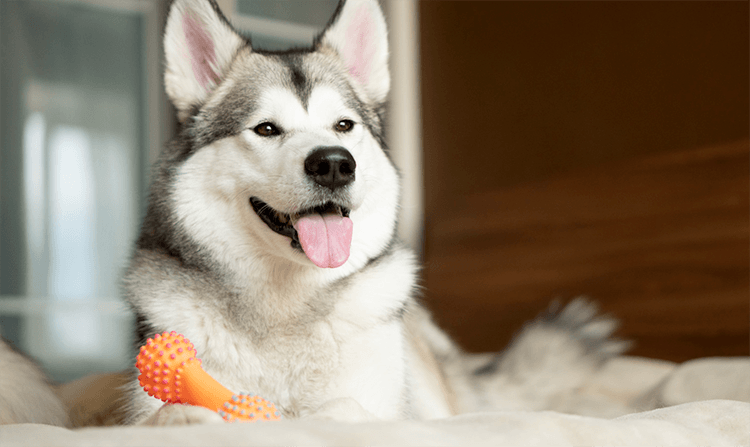Because Siberian Huskies are known for their thick fluffy coats, which help keep them warm during the winter or in Arctic conditions, many husky owners may be concerned that a husky’s thick coat may cause them overheating and discomfort during the summer months.
So should you shave a husky’s coat to help keep them cool?
Like other double-coated dogs, Siberian huskies should not be shaved unless necessary (whereby the shaving should be performed by a professional.) The reason for not shaving huskies is that this may expose them to sunburn, poor temperature regulation, and hair loss.
Consequently, although a shaved husky may appear comical and harmless, this is an inefficient method of caring for huskies.
There are more efficient and less intrusive methods of coat protection – which we’ll be exploring in this post!
Why Shouldn’t Huskies Be Shaved?

Commonly cited reasons for wanting to shave Siberian huskies are:
- To cool huskies down during the summer months by removing their thick coat, and
- To reduce the amount of shedding from huskies throughout the year.
Although, at face value, shaving a husky may seem like the most appropriate method of achieving these goals, the removal of a double coat (more on that below) can cause immense discomfort to a husky while doing little to maintain shedding.
Regarding the discomfort a husky will feel from shaving: shaving a husky’s coat has been proven to reduce a dog’s ability to regulate their body temperature, makes them more prone to sunburn, has long-term negative effects on growing fur, and exposes the skin to external elements such as dirt or parasites.
Furthermore, while shaving a husky may seem like an easy fix to fur shedding, this is an overly intrusive method of fur control that not only causes discomfort for the husky but may cost owners a lot of time and grooming fees to perform.
Consequently, huskies can be cooled down by more traditional and sustainable methods such as adequate hydration and walking during cooler parts of the day/evening.
While fur management and overall husky health can be better addressed by taking care of their coats through regular grooming and bathing.
What Is A Husky Double Coat?
Given the association with Siberian huskies and arctic climates, it’s understandable that many owners would view the double – coat of a husky as being a source of comfort and overheating during the summer months.
However, unlike an external feature/object such as a person wearing a big, heavy coat during the summer months, causing them to overheat. Double – coats are an inherent part of the anatomy of various dogs, making them an essential component in skin protection and heat regulation.
Consequently, to understand why a double coat is not a source of discomfort for huskies, it is worth the time to fully understand the purpose of the coat.
The topcoat is the long visible coat of the husky that gives them their distinctive fluffiness. Sometimes referred to as the guard coat, these long, straight hairs help protect huskies from the elements such as dirt, rain, sun rays, or insects.
The undercoat, which is not immediately visible, consists of shorter, softer hairs. These hairs lie beneath the topcoat and help regulate the body temperature of huskies in extremely hot and cold weather throughout the year.
Undercoats achieve this by acting as insulators, whereby the length and thickness of the coat change throughout the year and in response to different temperatures. The topcoat remains consistent in length, giving the impression that these long hairs are a burden to Siberian huskies during the summer months.
In conclusion, shaving a husky does little to nothing concerning the growth of the undercoat, meaning that it does not assist huskies with natural shedding and temperature regulation.
Instead, shaving removes the top coat of the husky, meaning that the coat which has nothing to do with temperature regulation is removed, resulting in an increased risk of sunburn, dirt exposure, insect bites, and permanent fur growth problems.
For these reasons, huskies, like other double-coated breeds such as German Shepherds and Golden Retrievers, should not be shaved unless directed by a veterinarian for medical reasons.
How To Take Care Of A Husky’s Coat?
While huskies may have big fluffy coats that appear unmanageable, they are relatively easy dogs to care for, provided you follow these simple steps:

Step 1: Brushing A Double Coat
Husky owners are advised to thoroughly brush their dog’s coat at least once a week to assist their dogs with the natural shedding process and avoid excessive shedding in the summer months.
While brushing your dog, make sure to use a wide-toothed comb for mattered fur and a paddle brush to straighten out the hairs of the coat.
Brush patterns should begin with the undercoat, whereby care is taken to brush away from the skin, followed by the overcoat, whereby brushing vigorously in the direction of the hair growth encourages shine and smoothness.
Step 2: Monitor Shedding
Your dog will shed more during the summer months. Once you notice increased shedding, make sure to follow the brushing techniques above to assist your dog with the shedding process so that they remain cool during the summer months.
Furthermore, this will reduce the likelihood of excessive shedding at any time in the year, resulting in less vacuuming around the house!
Step 3: Bathing A Husky
Huskies need to be bathed once a month. When doing so, pay particular attention to the shampoo used and rinse their coat after bathing, as excess shampoo can collect in their undercoats.
A Shaved Husky Is Not A Happy Husky!
In conclusion, double-coated dogs are unlikely to overheat, provided their coats are properly and consistently maintained.
Thus there should be little to no reason for you to shave your husky to keep them happy and healthy!
